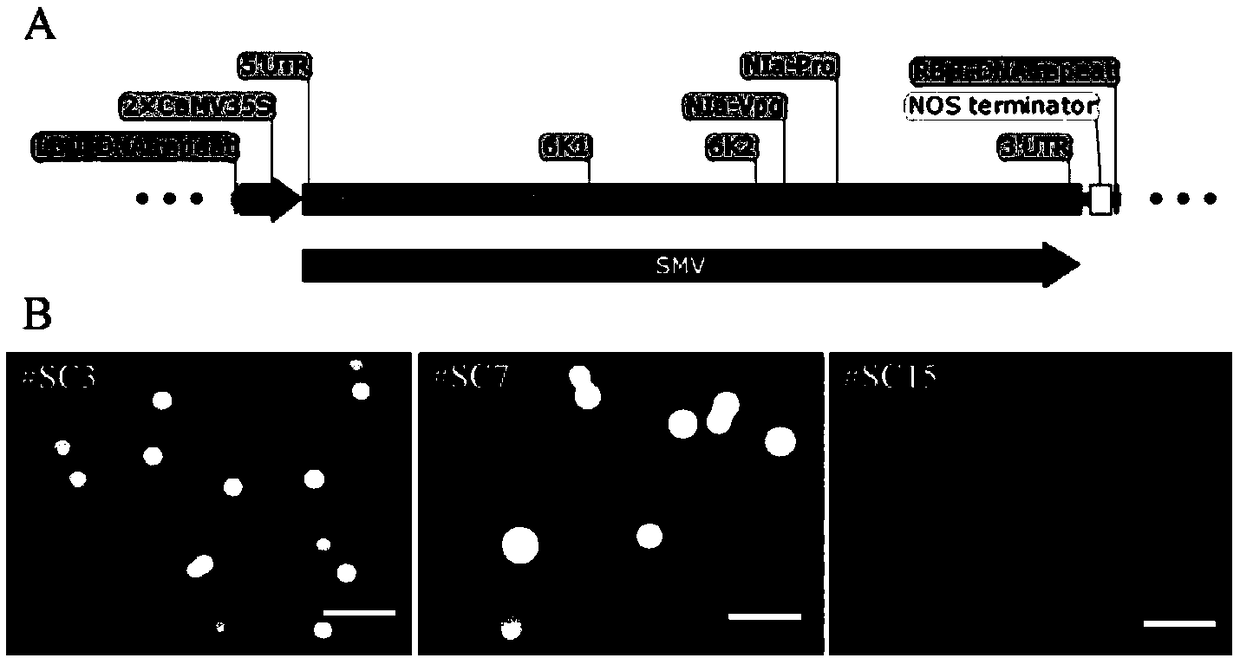Soybean mosaic virus sequence capable of inhibiting growth of agrobacteria and application of soybean mosaic virus sequence
A technology of soybean mosaic virus and Agrobacterium, applied in the field of genetic engineering, achieves the effect of remarkable inhibition ability, excellent practical performance and great application value
- Summary
- Abstract
- Description
- Claims
- Application Information
AI Technical Summary
Problems solved by technology
Method used
Image
Examples
Embodiment 1
[0024] Example 1: Discovery of Agrobacterium Growth Inhibitory Sequences in Soybean Mosaic Virus
[0025] 1. Construction of soybean mosaic virus cloning vector
[0026] We used trizol to extract total RNA from fresh SMV-infected soybean leaves; total RNA used TAKARA primescript TM ii 1st strand cDNA synthesis kit reverse transcription into cDNA. Using cDNA as a template, we divided SMV into 5 segments to amplify and purify and recover. The recovered above-mentioned PCR fragments (such as 1a, 2a, 3a, 4a, 5a five fragments) are directly transformed into Clontech's yeast strain Y2Hgold with the pCB301 vector linearized with StuI and SmaI, and use SD / -Trp medium Screen for recombinant clones. The plasmids extracted from single yeast colonies were verified by PCR and sequencing, and then the plasmids were amplified. The successfully constructed virus clones were named pCB301-SC3 (#SC3), pCB301-SC7 (#SC7) and pCB301-SC15 (#SC15), respectively. The strategy for obtaining each P...
Embodiment 2
[0042] Example 2: Application of SC15 Agrobacterium Growth Inhibition Sequence in Efficient Screening of Recombinant Clones
[0043] 1. Construction of pCB301-attL-SC15P vector
[0044] We replaced the sequence between LB and RB of the pCB301 vector with attL1 and attL2 sequences, and inserted a small fragment SC15P that can inhibit the growth of Agrobacterium between the attL1 and attL2 sequences, and the constructed vector was named pCB301-attL-SC15P( image 3 A, the complete sequence of pCB301-attL-SC15P is shown in SEQ ID NO.3). The construction process of pCB301-attL-SC15P is as follows: first, use the pGWB5 plasmid as a template, use primers attL1-301REC and attL2-301REC to perform PCR amplification to obtain fragment 1s, use pCB301 plasmid as a template, and use primers 301-frag-F and 301- Frag-R was amplified by PCR to obtain fragment 2s. The purified 1s and 2s fragments were ligated and transformed into Escherichia coli DH5α through the ClonExpress-II OneStep Cloning...
PUM
 Login to View More
Login to View More Abstract
Description
Claims
Application Information
 Login to View More
Login to View More - R&D
- Intellectual Property
- Life Sciences
- Materials
- Tech Scout
- Unparalleled Data Quality
- Higher Quality Content
- 60% Fewer Hallucinations
Browse by: Latest US Patents, China's latest patents, Technical Efficacy Thesaurus, Application Domain, Technology Topic, Popular Technical Reports.
© 2025 PatSnap. All rights reserved.Legal|Privacy policy|Modern Slavery Act Transparency Statement|Sitemap|About US| Contact US: help@patsnap.com



